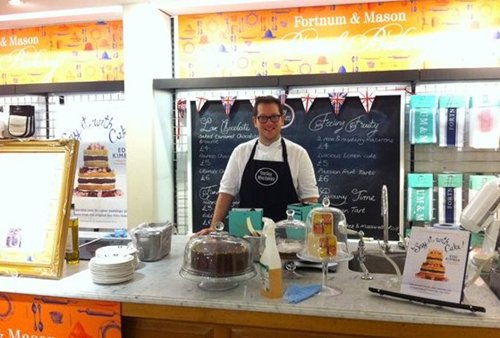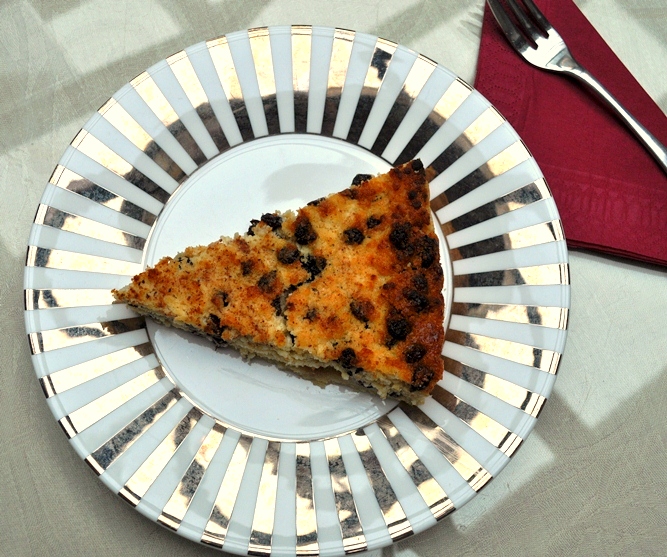The trouble with watching the Great British Bake Off, you might remember, is that it is very difficult to watch all of the wonderful cakes and pies being made, seeing Mary’s smile as her eyes close with delight, and you don’t get to taste any of it!
There are two days left when you can go to Fortnum and Mason’s in London and buy a slice of delicious cake from Edd Kimber, aka The Boy Who Bakes, the winner of the first series of BBC’s GBBO as it’s lovingly referred to by its many fans. We popped in last week and bought a slice of the chocolate cake and a salted caramel brownie (they’re made in the store with award-winning Amedei chocolate so it was hard to resist maxing out the cake purchases on chocolate-containing items).

There’s also a luscious looking lemon cake, Battenburg, Edd’s Granny’s gingerbread recipe and a few other special bakes.
Edd’s little temporary shop is part of a series of food professionals showcasing their wares at Fortnum’s. In a few short weeks you’ll get the chance to compare his to Mr Paul Hollywood himself. Here’s the rest of the line up:
11th February – 24th February 2013: Edd Kimber
25th February – 10th March 2013: Stacie Stewart
11th March – 24th March 2013: The Pocket Bakery
25th March – 7th April 2013: Paul Hollywood
They are all up the stairs to the left as you go in either of the Piccadilly entrances, on the first floor, and there are benches and chairs and fabulous Fortnum’s coffee and tea if you want to sit and enjoy your cake in Britain’s oldest department store.
Let us know if you make it and what you think in the comments below!
Our first cake adventure a few weeks ago took me to Yorkshire. Stepping into one of the many, many tea rooms in York I was presented with a trolley of cakes. One of these was a giant Yorkshire curd tart. Now, I’ve been to Yorkshire many times, but I’d not yet sampled one of these, nor had I even seen enough of them to be able to identify it without help. Shame on me. Given I’d spent the morning eating cake, the predominance of eggs and slight cheesiness of this tart made it quite an obvious choice to sample. Not to mention my intention to sample local specialities as well.

There isn’t an especially elegant way to describe a Yorkshire curd tart that will make it sound appealing. It’s an open pie with a short crust and a slightly lumpy custard-like filling (this is the “curds”). Studded with currants and incorporating nutmeg and lemon, I can imagine this dessert wouldn’t be to everyone’s liking, but if you’ve grown up in England there is something comforting about the combination of a baked sweet egg mixture with currants and crisp pastry or bread crunch to balance the texture. I’m still a sucker for bread and butter pudding. I particularly liked that this tart wasn’t an overly sweet tart. Despite the similarities in ingredients, I shouldn’t really compare A Yorkshire curd tart to a bread and butter pudding. The nutmeg is much more predominant, it also includes lemon, and the curds are very unique in texture. Where a bread and butter pudding is mostly made up of the egg and milk soaked bread, the curd mixture is the star of this pudding.
What they do have in common is that they have both been part of English baking for a very long time and came about as a way to use up leftover ingredients to provide a sweet treat for the family.
What exactly are curds?
Do you remember the Little Miss Muffet poem? Sat on her tuffet, eating her curds and whey? Curds and whey are both part of the cheese making process. Before we started pasteurising and homogenising milk, left to sour in warm conditions it would separate into lumps of soft protein (the curds) and cloudy liquid that’s also full of protein (the whey). The curds would be pressed and aged (fermented) to become cheese. With pastuerised milk, or to hurry the process, if you add lemon juice or something similarly acidic to warmed milk, stir and then leave it, you will see the same separation. To make most cheese, rennet is commonly used.
The story goes that generally farmers would have more curds than they wanted to make cheese with, so they used these leftover curds to make into these lovely tarts.
So what exactly goes into a Yorkshire curd tart?
There are many recipes online, but essentially the ingredients are as below; mostly store cupboard ingredients. Check you have them and then have a hunt online for a recipe. Let us know what you find. When we’ve finished travelling the country tasting cake, we might get back in the kitchen to bake one. In the meantime I’ll leave it in your hands. If you find and would recommend a good recipe, please let us know in the comments below.
NOTE: Do make sure the ingredients include nutmeg. I saw at least one that doesn’t and it isn’t a proper curd tart without it. And also don’t even think about making it with cottage cheese!
Fine Shortcrust Pastry
Plain flour
Caster sugar
Butter
Water or milk
Egg yolks (optional)
For the filling
Full fat milk
Juice and zest of a lemon
Unsalted butter
Caster sugar
Nutmeg
Egg
Currants
Rosewater (optional)
Cinnamon (optional)
There are so many unsung wonderful cake shops and tea rooms around this beautiful country that we wanted to celebrate them. This website and our book, Great Cake Places London 2012 and Great Cake Places Britain, out in June 2013, intends to do exactly that.
Right now you'll find details of all of the best cake shops and afternoon tea places in London on our website. Please, have a look around!
We’re going to spend the next few months travelling around Britain visiting the best cake places. We will be updating this blog with some of our findings, as well as recipes, new cafe and cake shop opening and other general cake news. If you have a cake place anywhere in Britain you would like to recommend, please click here to tell us all about it!